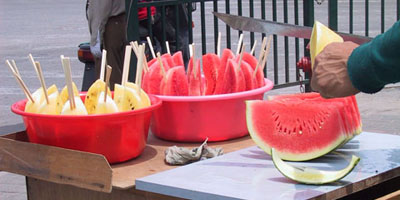It’s a long march to the melon
The meals in China have truly been great. We’ve commented repeatedly on how the communal Lazy Susan-style delivery of multiple dishes is the perfect way for Westerners to encounter new foods. Take a bit, leave a bit, or just keep on spinning the wheel if you don’t like black jellied mystery meat. The only difficulty is that it is hard to know where you are in a meal. The number of dishes is sometimes unknown even to our hosts. Watermelon is always the last dish, but, as you learn quickly, it can be a long march to the melon.
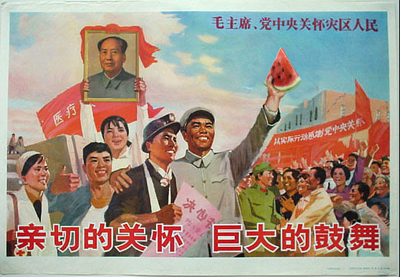
Thanks to Jack Blanchard for this exquisite piece of gastronomical propaganda. Gastroprop?
The beast approacheth
Haitang is now a Category 5 Super Typhoon. And it is headed straight for the island of Taiwan. The eye will likely make landfall on Monday night. The red arrow helps you locate me. If you look closely I’m the one inadvisably standing in front of a big plate glass window.
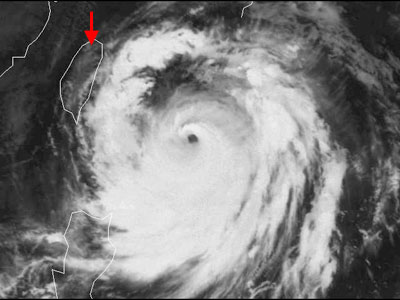
Who would have guessed my first hurricane would be in the Pacific? Batten down the hatches!
Yin to the yang
The amazing growth of Beijing continues. Construction cranes everywhere, miserable traffic, mundane and mind-bending architecture all mixed together. In some far-future time when urban archaeologists are excavating the once-mighty Chinese capital they will be able to date it like a tree merely by counting the number of ring roads.
I haven’t given Chinese public toilets — and by that I mean putrid holes in the ground — much consideration, but then this is the first real working trip I’ve had here with a female teammate — and she ain’t happy. Doing the right-angle levitation thing seems tricky indeed. I suggest two innovations:
(1) How about a belt-like waist harness that attaches to the door of the stall (if there is a door) which allows you to lean back, almost as though you were sitting throneward? Heaven help you if the harness breaks, but would be a lot easier on the calves.
(2) Disposable plastic heel protectors, like reverse sandals, in case your bombadier skills are lacking.
It did occur to me that Westerners must seem like the dirty ones to Chinese accustomed to hole-squatting. A skilled squatter never touches his/her skin to any surface whereas we occidental types must actually come in contact with germ-laden toilet seats. While it has been noted that levitating over a toilet is easier than levitating over a hole, I think this might be psychological. (My co-worker’s blog Why We Work has much more on this.)
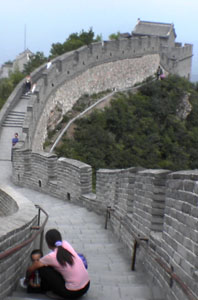
Speaking of excrement, I climbed the Great Wall again a few days ago. On my descent from the top I encountered a small child being urged to take a crap in a plastic bag. (See photo.) Gross, but that’s about all you could do up there. When he finished the mother packaged up the bag like an urban dog-walker — and then proceeded to pitch it over the wall! But the wind caught it and blew it right back on to the poor kid! The gods of the Wall had the last laugh. But I had the second-to-last laugh.
On a brighter note, I haven’t yet been barfed at on this trip. (Hey, it happens.) Still some time to go though.
Much of meal conversation has been about language. (Thought I’d say excrement or something, didn’t you?) We were talking about regional differences and the difficulty of using idioms when the topic of sun showers came up. Specifically, the ways different cultures refer to the phenomenon of rain when the sun is shining. I always called them sun showers but was recently intrigued to learn that some people in the American South refer to this as “the devil is beating his wife”. The Chinese loved this euphemism. In China a sun shower is known as “love-not love” or unrequited love. I like that a lot. In Russian (according to a Moldovan teammate) this phenonmemon is known as “blind rain” because the rain cannot see that it is also sunny out. See, conversation like this is good when you’re not in the mood for the duck tongue that’s just been served.
I played in a small ping pong tournament at the Forbidden City a few days ago. Me and three colleagues — two Chinese, one American — took on the best that the Palace Museum could offer. We got killed. I mean, these people had ping pong shoes on, for god’s sake. Scary part was that after the whomping they brought out two “professionals” who they clearly had waiting in the wings in case by some miracle we didn’t suck as bad as they figured we would (and did). They played an exhibition match and it was exactly what you’d expect: standing ten feet back from the table, paddles upside-down, smacking the hell out of the ball, forty-hit rallies. My neck was sore from watching.
See also new phonecam pics at Flickr.
Hey, what’s the food like in China?
Here’s a partial dissection of a truly wonderful lunch in the Imperial Kitchen of the Forbidden City. (Click for notes.)
Today was a scorcher full of meetings in Beijing. I started the day in a coat and tie and ended in an undershirt and sweaty socks. Fill in what you like.
Laughter, horror, frustration
CCTV had a professional badmitton tournament on the other day. It was about the funniest thing I have seen in months. So serious, so intense, so … badmitton. I’m sorry, people, I know you are athletes, but you simply cannot look cool smashing a shuttlecock. And lest you think this is a comment on Chinese culture I’ll note that the combatants were Euro of some flavor. (Implicit comment on Chinese viewing habits, I s’pose.)
Today in the antiques market I came within inches of slicing off a parabola of projectile vomit with my chest. Luckily this happened to me in Shanghai, also in a market — not kidding — so I was more than normally alert to being barfed on and I was able to leap out of the way. Shoes got a bit, though. What the hell?
Back in early 1996 in Atlanta people decried the traffic paralysis that would acommpany the Olympics. This never happened. People took public transport (which of course caused all kinds of other problems) and I-75/85 was no more sclerotic than usual. So maybe things will be OK in 2008, but I fear so much worse. Beijing is six rings of traffic hell. Rush hour does not exist. It just is. Arrrrrghhh!
Some thoughts on translation

Presenting/demonstrating to an audience who does not speak your language and without real-time translation is not easy. Having a translator in non-real time requires you to think in complete, self-contained chunks — something I do not do. My thought-process (which is reflected in my presentation style) does loop-dee-loops, dithers in cognitive cul-de-sacs, and lurches forward without notice. This doesn’t mesh so well with the discrete communicational quanta required by the translator.
Translations of food descriptions into English rarely help and often make the dish far less appetizing. I’d rather be left to my ignorance of the original Chinese and take my chances. Just guessing at the Pinyin would be so much safer than actually reading “brown sauce from duck entrails,” for example.
There has to be a point at which signage translation into English crosses the line from useful to being more effort than it is worth to make sense of the grammar. I don’t have a ready example, but sometimes signage translations here are so muddled that you’d spend your time better looking for non-textual clues than trying to decipher the English. (Of course, sometimes it is worth it to read.)
Hyphenated translations from a culture whose language never needs hyphenation reminds you how strange it is to see hyphenation done improperly. To native speakers, the hyphen can only intrude at certain places in a word and certainly never to begin a line. Here, the hyphen is much bolder, splitting words wherever it damn well pleases. I like this. Punctuation with chutzpah.
See also: Words Are Pretty. (Seems to have stagnated of late, but I am banking on it revving back up.)
Chengde
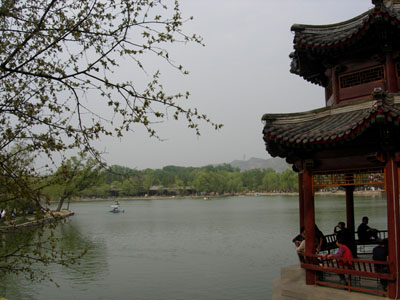
My colleagues and I made a 4-hour trek to Chengde today. A summer palace of the Qing-era emperors in the mountains northeast of Beijing, Chengde is now a secondary tourist destination. It’s distance from the capital is great enough that you avoid most of the Great Wall tourist fly-bys that clog Badaling. In fact, en route to Chengde you pass some lovely half-ruined sections of the wall (at Simatai, I believe). Problem is, the wall was as interesting as Chengde itself. I wasn’t all that impressed. The grounds of the summer resort verge on dilapidation and the palaces themselves — like those in the Forbidden City — could only be peered into from behind glass. The interiors, also as in Beijing, were dust-draped Imperial still lifes, static and moribund. The rooms felt like tombs to me. Still, the vastness of the resort was sublime and the pagoda-lined lakes lovely. Verdict: not worth 8 hours in the car.
Shang High
Well this is certainly an amazing city. I figured it would be difficult for Shanghai to live up to the hype it has received of late, but I’m unable to really refute things after having spent the better part of the day wandering around the city. Shanghai is comprised of three fairly distinct urban experiences. The newest area, Pudong, is straight out of Blade Runner, all dizzyingly vertical, clad in neon and LCD. The Oriental Pearl TV Tower looks ready for its encounter with the monolith from 2001 while the Jin Mao Tower sports the highest hotel (which I am in) in the world. Looking out my window I stare at three or four skyscraper-topping helipads and half-expect to see early-morning Tai Chi exercises atop them.
The Huangpu river divides Pudong from the main areas of Shanghai. A constant armada of barges and support craft ply the wide river making obvious that commerce is the lifeblood of this city. On foot you cross the river via a futuristic subterranean tunnel that uses four-man pods on electric rails to whisk you through what can only be described as the bastard child of the United Airlines terminal pedway at O’Hare and EPCOT Center. Cheesy, but fun to look at — once.
The Bund, as Europeans called the corniche promenade in the early part of last century, is a striking colonial contrast to the pomo Pudong. You’d almost think you were in pre-war Europe. Actually the opening scene from Indiana Jones and the Temple of Doom comes to mind. Beautiful, yes, but it stares across the river at the gleaming otherworldiness of Pudong and seems anachronistic and mildly pathetic. Architectural evidence of the years between colonialism and China’s recent resurgence is, thankfully, missing — at least here.
Proceeding south into Old Shanghai, you quickly find yourself in a tangled knot of vendor-strewn alleys, meaty odors, and hidden gardens. It is enchanting, actually. A tea house built atop stilts in the middle of a small lake. Rock grottos perfect for forgetting you are in a city of 16 million people. Ponds dense with koi and tourists staring back at them.
First impressions. But clearly the intersection of these diverse urban experiences is the engine (or at least one of the cylinders) powering Shanghai’s stunning vitality.
All Flickrlicious photos here.
See also Dan Washburn’s Shanghai Diaries. Excellent blog.
Umbrella locker in Nanjing
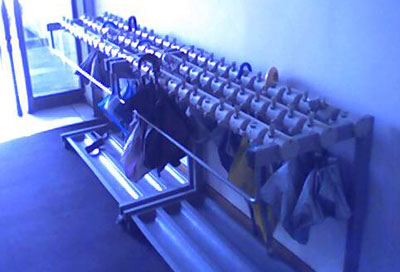
Note the drip runoff troughs. Nice design.



